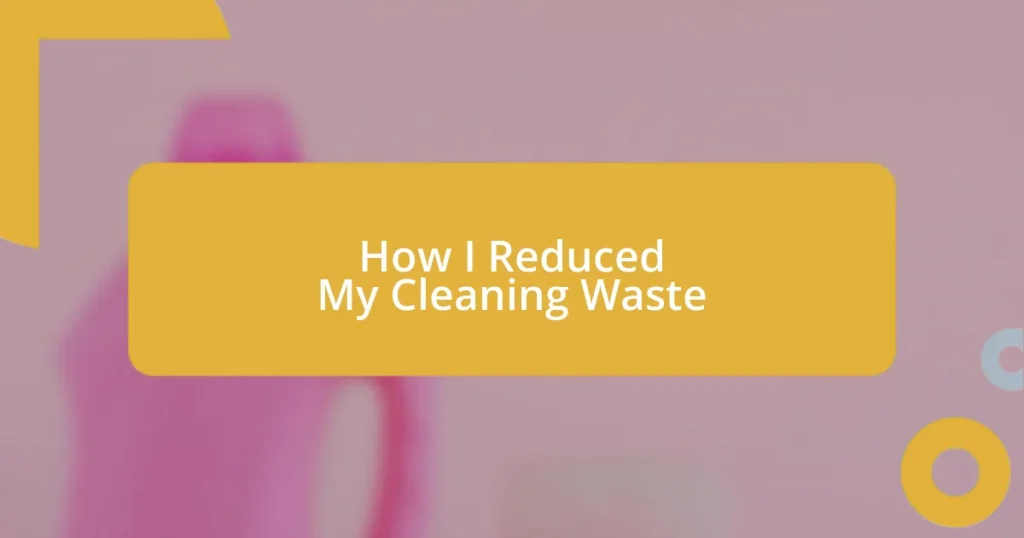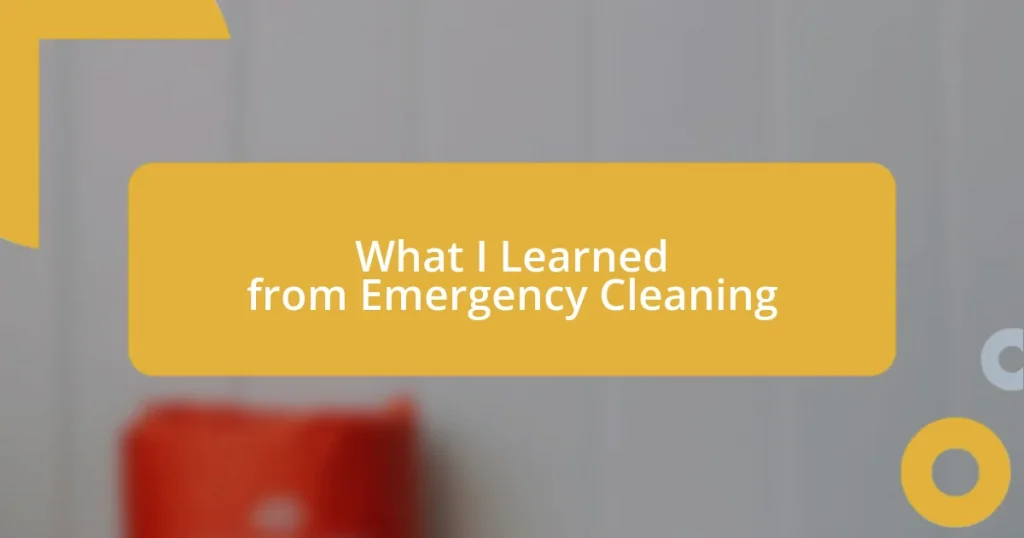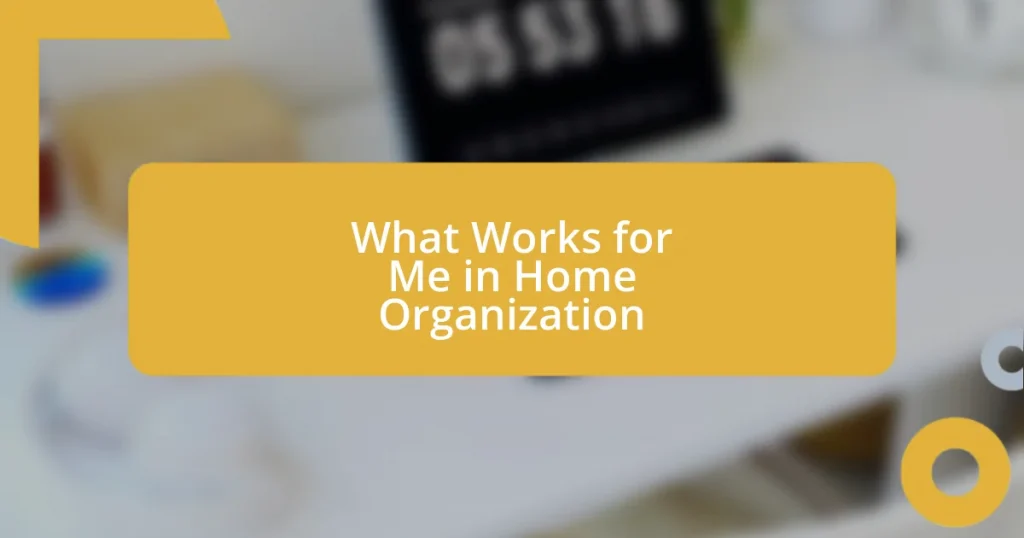Key takeaways:
- Switching to reusable cleaning products, such as cloths and mop pads, significantly reduces waste and promotes more mindful consumer habits.
- Exploring eco-friendly alternatives, like homemade cleaning solutions, can be empowering and effective while minimizing reliance on single-use items.
- Sharing experiences and hosting events, like a “Cleaning Product Swap,” encourages community engagement and inspires others to adopt sustainable practices.
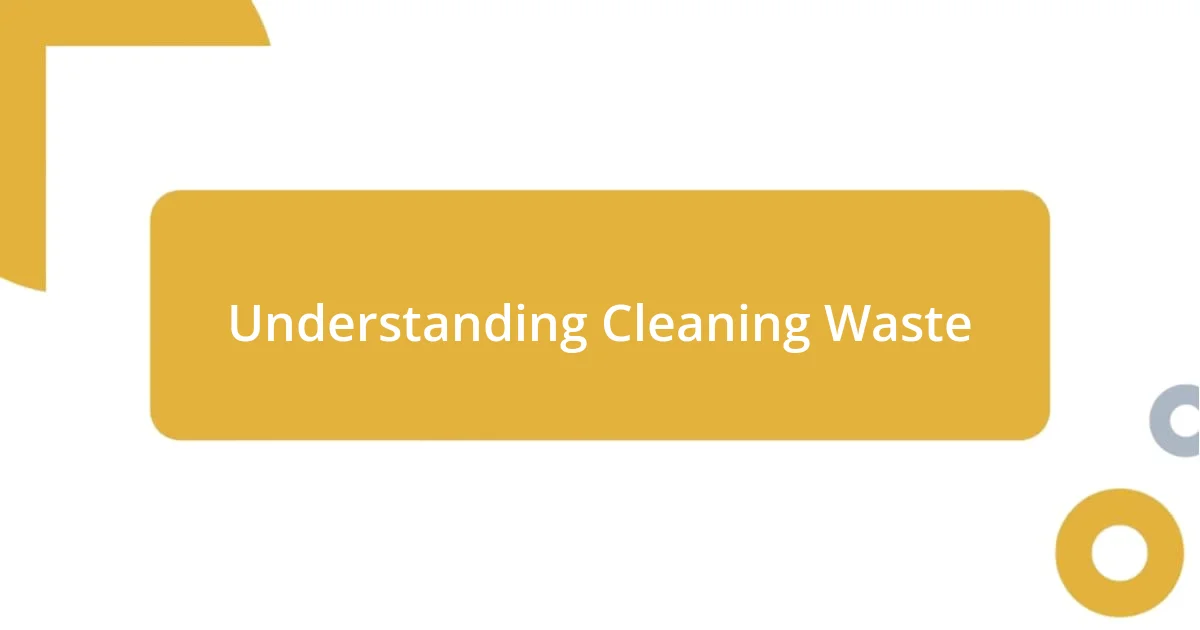
Understanding Cleaning Waste
Cleaning waste often goes unnoticed in our everyday routines, yet it can accumulate quickly. I remember a time when I filled trash bags with used paper towels, plastic bottles, and cleaning product containers without a second thought. Reflecting on that now, I can’t help but wonder: how much of this waste was truly necessary?
As I delved into reducing my cleaning waste, I realized that many common cleaning products contribute massively to our landfills. It’s striking to think about the single-use items I was regularly discarding. Each time I held an empty spray bottle, it felt like a missed opportunity to make more conscious choices.
The truth is, cleaning waste isn’t just about what we throw away; it reflects our habits and values. I often think about the first time I switched to reusable cleaning cloths instead of paper towels. It was a small step, but witnessing the amount of waste I was no longer generating brought a sense of fulfillment I had never anticipated. Have you ever experienced that moment of clarity, realizing the impact of seemingly small changes?
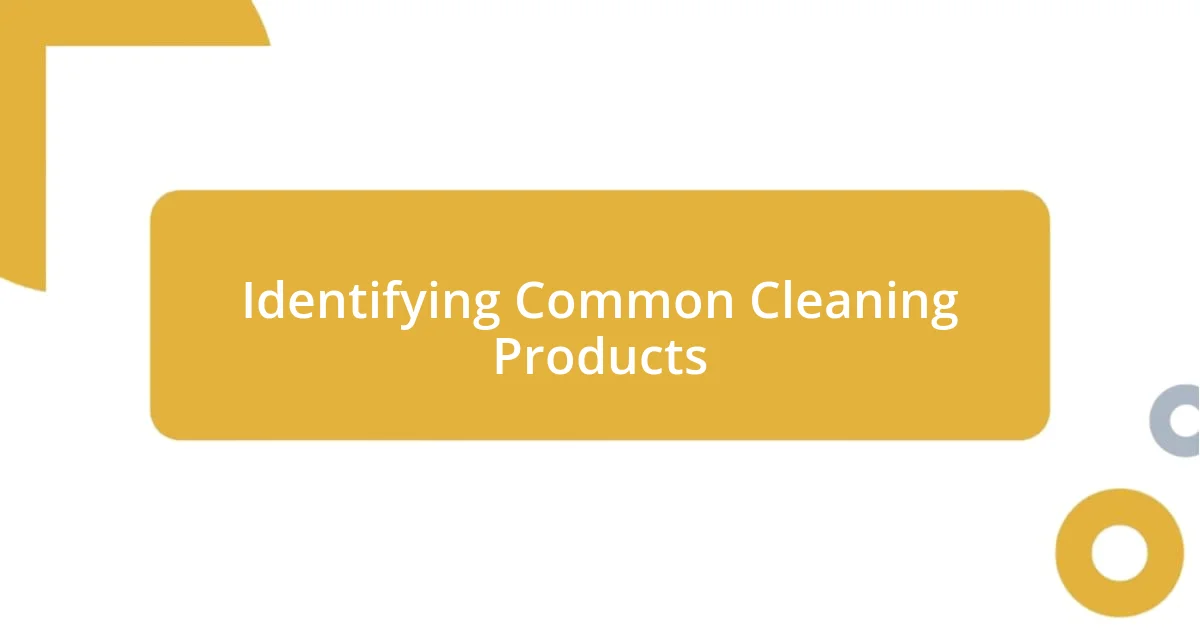
Identifying Common Cleaning Products
Identifying common cleaning products can truly open our eyes to the waste they generate. For instance, I used to stockpile multi-surface cleaners, not realizing many of those bottles would end up in the trash. When I finally gathered my old products and counted them, I was shocked by how many I had accumulated, some of which were barely used.
As I explored eco-friendlier options, I found myself reflecting on the sheer volume of disposable items. Did you know that disposable dusters and mop pads are easy to overlook but contribute significantly to waste? I remember standing in the aisle, feeling conflicted as I weighed convenience against the waste generated. It was a lightbulb moment for me that led me to rethink my purchasing habits and seek out reusable alternatives.
To illustrate just how prevalent certain products are, take a look at this table comparing common cleaning products to their eco-friendly counterparts. This visual representation underscored the substantial difference in waste generation, reinforcing my decision to choose wisely.
| Common Cleaning Product | Eco-Friendly Alternative |
|---|---|
| Single-use paper towels | Reusable cleaning cloths |
| Plastic spray bottles | Refillable glass bottles |
| Disposable mop pads | Washable mop pads |

Evaluating Eco-Friendly Alternatives
When I started evaluating eco-friendly alternatives for cleaning, I remember feeling a mix of hope and skepticism. Going green seemed like a daunting task, but each product I researched revealed new, exciting options. For instance, the first time I switched from a chemical-laden all-purpose cleaner to a homemade vinegar solution, it felt surprisingly liberating. I couldn’t believe that simple ingredients could be just as effective, if not more so, than those fancy brands filled with mystery ingredients. My counter was gleaming, and I felt good knowing I was also minimizing my footprint on the environment.
- Natural ingredients like baking soda and vinegar can clean effectively without harmful chemicals.
- Brands focusing on sustainable packaging reduce plastic waste significantly.
- Many eco-friendly cleaning products are concentrated, meaning less packaging is needed overall.
As I continued my journey, I stumbled upon the concept of zero-waste cleaning. I was initially overwhelmed by the idea, but then I realized it could actually simplify my life. Switching to a few quality items—like a sturdy broom and a washable mop—allowed me to stop buying countless disposable items. That moment of clarity, when I no longer needed to make constant trips to the store for replacements, was priceless. I felt lighter, both physically and mentally, like I’d shed a layer of unnecessary clutter.
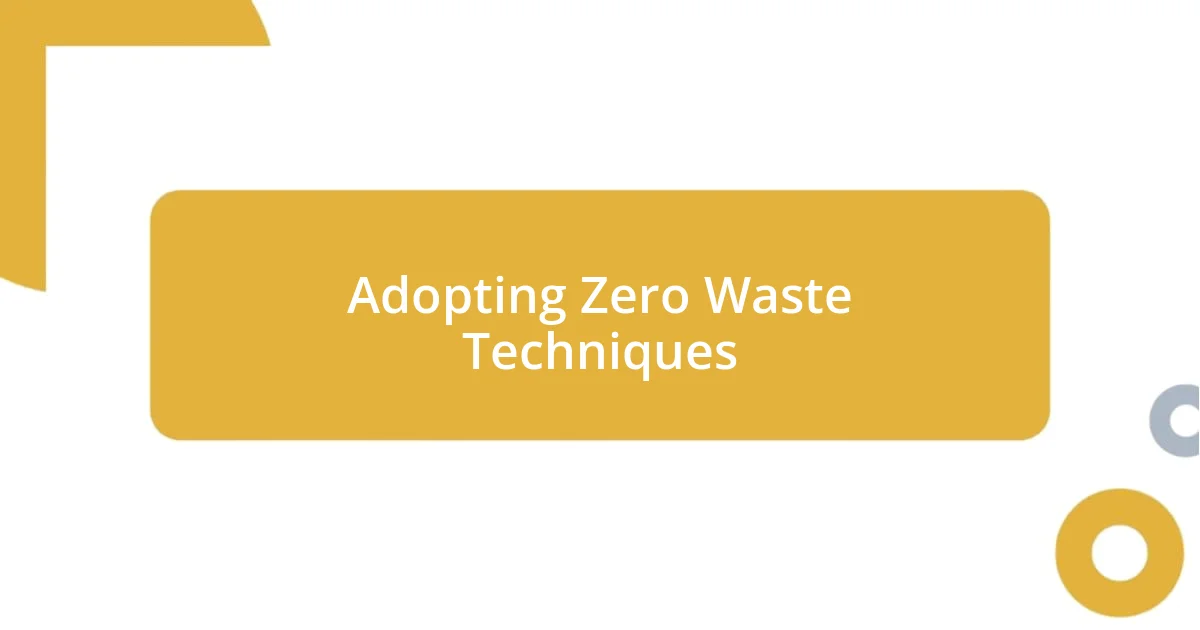
Adopting Zero Waste Techniques
As I began to adopt zero waste techniques, I found the process both thrilling and daunting. It was like peeling back layers of my own consumer habits—did I really need all those individual products cluttering my cabinets? Switching to refillable systems made me recognize how rewarding it is to reduce packaging waste while still keeping my home spotless.
One shift that deeply resonated with me was using homemade cleaning solutions. I remember spending an afternoon experimenting with various recipes—mixing essential oils with vinegar and baking soda—until I found the perfect combination that left my home smelling fresh. The sense of accomplishment I felt when I realized I could create effective cleaners from items already in my pantry was empowering. Why hadn’t I done this sooner?
Integrating reusable tools, like my favorite washable cloths, transformed not just my cleaning routine, but my mindset as well. I’ll never forget the first time I mopped my floor with a reusable pad instead of a disposable one—it was a tangible reminder of the waste I had been contributing to. I began asking myself deeper questions about my purchasing decisions: How often can I reuse this? Is it worth the waste? This new perspective continued to shape my approach to all aspects of my life, encouraging me to be more mindful and intentional in my everyday choices.

Implementing Efficient Cleaning Routines
After I implemented efficient cleaning routines, my home transformed not just in cleanliness but in how I approached tasks. One day, I decided to set a timer during my cleaning sessions, which might sound simple, but it changed everything. I focused on one area at a time, and surprisingly, I completed my chores quicker and with less frustration. It was like discovering a hidden treasure of time!
Finding a rhythm in my cleaning routine brought an unexpected sense of satisfaction. I often mix household chores with enjoyable music or a podcast, turning what used to be a chore into a mini celebration. I remember jamming out while scrubbing the kitchen counters; I looked forward to cleaning instead of dreading it. Have you ever tried making chores enjoyable? It can truly change your perspective.
By planning my cleaning schedule weekly, I discovered an unexpected benefit: reduced waste. I noticed that tackling a specific area, like the bathroom or living room, focused my efforts. It also allowed me to use fewer products since I developed a routine that maximized efficiency. Reflecting on it, I can’t help but feel liberated not just by a cleaner space, but by the time I reclaimed for other meaningful activities in my life. Have you established a routine that works for you? Finding that rhythm is so rewarding!

Tracking My Cleaning Waste Reduction
Tracking my cleaning waste reduction became a fascinating journey that required me to be both observant and honest with myself. Each week, I took notes on the types of products I used and the waste they generated. This simple practice revealed surprising patterns; for instance, I never realized how much paper towel waste I was creating until I recorded it. Have you ever had a wake-up call like that?
I started logging my usage after I switched to reusable options like washcloths and mop pads. Initially, I thought keeping track would be a tedious task, but it transformed into something much more motivating. I vividly remember the moment I saw my waste decrease significantly—it felt like a small victory. How rewarding is it to see tangible progress in your efforts? For me, it turned tracking into a source of pride.
As I continued monitoring my habits, I came to appreciate the connection between waste tracking and mindfulness. Every time I would jot something down, it encouraged me to think twice before reaching for a disposables product. It was as if I was cultivating a plant of awareness; the more attention I gave it, the stronger and more rooted it became. Do you find yourself growing in awareness when you keep a journal of your habits? I often encourage friends to try it; it’s enlightening how these small changes and reflections can lead to a big impact over time.

Sharing Tips for Others
Sharing my tips for reducing cleaning waste has been a rewarding experience, especially when I see others inspired to make changes as well. One of the most impactful steps I’ve taken is to host a “Cleaning Product Swap” with friends. This simple event not only decluttered my space but also allowed us to share effective, sustainable products. Have you ever considered how much you can learn from those around you? It’s both practical and insightful—a win-win!
In my journey, I found that talking openly about my experiences sparked curiosity among my peers. I remember sharing my triumphs and struggles during a casual dinner, which led to a lively discussion about our eco-conscious efforts. This exchange brought new ideas to the table, helping us all think creatively about waste reduction. Isn’t it interesting how a conversation can inspire and motivate others? Encouraging these discussions has become an essential part of my commitment to change.
Sometimes, even a small tip can have a significant impact. I often suggest to friends that they try creating a “no-waste” cleaning kit using items they already own—like vinegar and baking soda. Just the other day, a friend texted me excitedly after trying it out and realizing how effective it was. Have you experienced that joy of discovering a simple solution? It’s moments like these that make sharing knowledge worthwhile, reinforcing the idea that together, we can all contribute to a greener, cleaner home.










